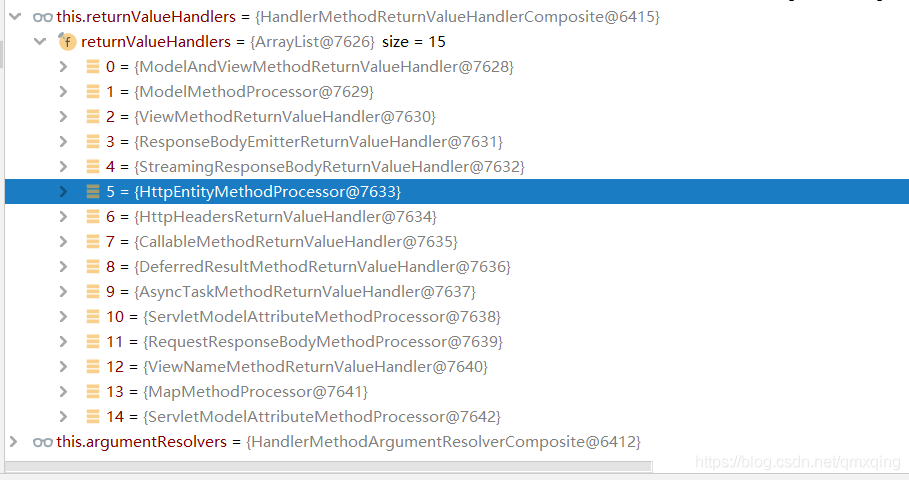SpringBoot与SpringMVC中参数传递的原理解析
目录
- 一:普通参数与基本注解
- 二:复杂参数
一:普通参数与基本注解
HandlerMapping中找到能处理请求的Handler(Controller,method())
为当前Handler找一个适配器HandlerAdapter:RequestMappingHandlerAdapter

1.HandlerAdapter

0-支持方法上标注@RequestMapping
1-支持函数式编程的
xxxx
2.执行目标方法


3.参数解析器:确定要执行的目标方法每一个参数的值是什么


boolean supportsParameter(MethodParameter parameter);
Object resolveArgument(MethodParameter parameter, @Nullable ModelAndViewContainer mavContainer,
先判断是否支持该参数类型, 如果支持, 就调用resolveArgument解析方法
4.返回值处理器

5.挨个判断所有参数解析器哪个支持这个参数:HandlerMethodArgumentResolver: 把控着支持的方法参数类型

请求进来后, 首先从handlerMapping中查找是否有对应的映射处理, 得到映射适配器Adapter,再通过适配器,查找有哪些方法匹配请求,首先判断方法名,以及参数类型是否匹配,首先获得方法中声明的参数名字, 放到数组里,循环遍历27种解析器判断是否有支持处理对应参数名字类型的解析器,如果有的话,根据名字进行解析参数,根据名字获得域数据中的参数, 循环每个参数名字进行判断, 从而为每个参数进行赋值.
对于自定义的POJO类参数:
ServletRequestMethodArgumentResolver 这个解析器用来解析: 是通过主要是通过判断是否是简单类型得到的
@Override
public boolean supportsParameter(MethodParameter parameter) {
return (parameter.hasParameterAnnotation(ModelAttribute.class) ||
(this.annotationNotRequired && !BeanUtils.isSimpleProperty(parameter.getParameterType())));
}
public static boolean isSimpleValueType(Class<?> type) {
return (Void.class != type && void.class != type &&
(ClassUtils.isPrimitiveOrWrapper(type) ||
Enum.class.isAssignableFrom(type) ||
CharSequence.class.isAssignableFrom(type) ||
Number.class.isAssignableFrom(type) ||
Date.class.isAssignableFrom(type) ||
Temporal.class.isAssignableFrom(type) ||
URI.class == type ||
URL.class == type ||
Locale.class == type ||
Class.class == type));
}
public final Object resolveArgument(MethodParameter parameter, @Nullable ModelAndViewContainer mavContainer,
NativeWebRequest webRequest, @Nullable WebDataBinderFactory binderFactory) throws Exception {
Assert.state(mavContainer != null, "ModelAttributeMethodProcessor requires ModelAndViewContainer");
Assert.state(binderFactory != null, "ModelAttributeMethodProcessor requires WebDataBinderFactory");
String name = ModelFactory.getNameForParameter(parameter);
ModelAttribute ann = parameter.getParameterAnnotation(ModelAttribute.class);
if (ann != null) {
mavContainer.setBinding(name, ann.binding());
}
Object attribute = null;
BindingResult bindingResult = null;
if (mavContainer.containsAttribute(name)) {
attribute = mavContainer.getModel().get(name);
}
else {
// Create attribute instance
try {
attribute = createAttribute(name, parameter, binderFactory, webRequest);
}
catch (BindException ex) {
if (isBindExceptionRequired(parameter)) {
// No BindingResult parameter -> fail with BindException
throw ex;
}
// Otherwise, expose null/empty value and associated BindingResult
if (parameter.getParameterType() == Optional.class) {
attribute = Optional.empty();
}
else {
attribute = ex.getTarget();
}
bindingResult = ex.getBindingResult();
}
}
if (bindingResult == null) {
// Bean property binding and validation;
// skipped in case of binding failure on construction.
WebDataBinder binder = binderFactory.createBinder(webRequest, attribute, name);
if (binder.getTarget() != null) {
if (!mavContainer.isBindingDisabled(name)) {
bindRequestParameters(binder, webRequest);
}
validateIfApplicable(binder, parameter);
if (binder.getBindingResult().hasErrors() && isBindExceptionRequired(binder, parameter)) {
throw new BindException(binder.getBindingResult());
}
}
// Value type adaptation, also covering java.util.Optional
if (!parameter.getParameterType().isInstance(attribute)) {
attribute = binder.convertIfNecessary(binder.getTarget(), parameter.getParameterType(), parameter);
}
bindingResult = binder.getBindingResult();
}
// Add resolved attribute and BindingResult at the end of the model
Map<String, Object> bindingResultModel = bindingResult.getModel();
mavContainer.removeAttributes(bindingResultModel);
mavContainer.addAllAttributes(bindingResultModel);
return attribute;
}
WebDataBinder binder =binderFactory.createBinder(webRequest,attribute,name)
WebDataBinder:web数据绑定器,将请求参数的值绑定到指定的javaBean里面
WebDataBinder 利用它里面的Converters将请求数据转成指定的数据类型,通过反射一系列操作,再次封装到javabean中
GenericConversionService:在设置每一个值的时候,找它里面所有的converter哪个可以将这个数据类型(request带来参数的字符串)转换到指定的类型(javabean—某一个类型)


未来我们可以给WebDataBinder里面放自己的Converter
private static final class StringToNumber implements Converter<String, T> {
converter总接口:
@FunctionalInterface
public interface Converter<S, T> {
//自定义转换器:实现按照自己的规则给相应对象赋值
@Override
public void addFormatters(FormatterRegistry registry) {
registry.addConverter(new Converter<String, Pet>() {
@Override
public Pet convert(String source) {
if (!StringUtils.isEmpty(source)){
Pet pet = new Pet();
String[] split = source.split(",");
pet.setName(split[0]);
pet.setAge(split[1]);
return pet;
}
return null;
}
});
}
二:复杂参数
Map/Model(map/model里面的数据会被放在request的请求域 相当于request.setAttribute)/Errors/BindingResult/RedirectAttributes(重定向携带数据)/ServletRespons().SessionStaus.UriComponentsBuilder
6.在上面第五步目标方法执行完成后:
将所有的数据都放在ModelAdnViewContainer;包含要去的页面地址View,还包含Model数据

7.处理派发结果
processDispatchResult(processedRequest, response, mappedHandler, mv, dispatchException);
在页面进行响应前, 进行视图渲染的时候:
exposeModelAsRequestAttributes(model, request); 该方法将model中所有参数都放在请求域数据中
protected void renderMergedOutputModel(
Map<String, Object> model, HttpServletRequest request, HttpServletResponse response) throws Exception {
// Expose the model object as request attributes.
exposeModelAsRequestAttributes(model, request);
// Expose helpers as request attributes, if any.
exposeHelpers(request);
// Determine the path for the request dispatcher.
String dispatcherPath = prepareForRendering(request, response);
// Obtain a RequestDispatcher for the target resource (typically a JSP).
RequestDispatcher rd = getRequestDispatcher(request, dispatcherPath);
if (rd == null) {
throw new ServletException("Could not get RequestDispatcher for [" + getUrl() +
"]: Check that the corresponding file exists within your web application archive!");
}
// If already included or response already committed, perform include, else forward.
if (useInclude(request, response)) {
response.setContentType(getContentType());
if (logger.isDebugEnabled()) {
logger.debug("Including [" + getUrl() + "]");
}
rd.include(request, response);
}
else {
// Note: The forwarded resource is supposed to determine the content type itself.
if (logger.isDebugEnabled()) {
logger.debug("Forwarding to [" + getUrl() + "]");
}
rd.forward(request, response);
}
}
通过循环遍历model中的所有数据放在请求域中
protected void exposeModelAsRequestAttributes(Map<String, Object> model,
HttpServletRequest request) throws Exception {
model.forEach((name, value) -> {
if (value != null) {
request.setAttribute(name, value);
}
else {
request.removeAttribute(name);
}
});
}
不管我们在方法形参位置放 Map集合或者Molde 最终在底层源码都是同一个对象在mvcContainer容器中进行保存
到此这篇关于SpringBoot与SpringMVC中参数传递的原理的文章就介绍到这了,更多相关SpringBoot SpringMVC参数传递内容请搜索我们以前的文章或继续浏览下面的相关文章希望大家以后多多支持我们!

